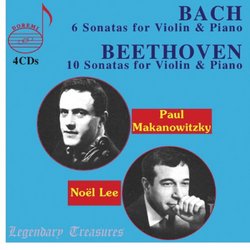Outstanding Artistry in Variable Sound
Johannes Climacus | Beverly, Massachusetts | 04/23/2009
(5 out of 5 stars)
"Where has the Makanowitzky-Lee Duo been all my life? These outstanding renditions of the Beethoven and Bach duo sonatas have evidently languished in obscurity for decades; too bad, because they are fully competitive with the best ever recorded. Indeed, I will go out on a limb here and say that, apart from two minor qualifications, these are the most musically satisfying versions of both duo-sonata cycles that I have heard--and I have longstanding preferences in this repertoire (the very different approaches of Kremer/Argerich and Grumiaux/Haskil in the Beethoven and Waterman/Ritt in the Bach).
Let me get the two qualifications out of the way before I proceed further. In the first place, I was keenly disappointed, given the astonishing quality of these performances, that Makanowitzky and Lee (perhaps at the behest of their producers) omit most repeats; their absence is particularly damaging in the Bach sonatas, where the second time around affords opportunities for varying dynamics, ornamentation and the prominence given to certain parts in the contrapuntal texture. Without repeats, too, certain movements suffer a significant loss in stature (the concluding "Vivace" of the f-minor, no. 5, provides a good example). In the second place, the source material for this reissue derives not from master tapes (one wonders whether they unobtainable or lost) but from obviously well-used LP's. Even though these vinyl discs were by no means in atrocious condition, the soundstage from time to time becomes cluttered with various configurations of swish, crackle pop and what sounds like "inner-groove distortion." More serious is the audible low hum or rumble that plagues many of the Beethoven sonatas, particularly the *Kreuzer*, and which makes listening with high-end headphones unpleasant. In general, the Bach, recorded in early stereo, gives the music more room to breathe than the rather cramped acoustics of the monaural Beethoven.
But in the end it would be curmudgeonly to dwell on these sonic deficiencies, given the astonishing quality of these performances. The Bach sings and soars, dances and prances in the fast movements; evokes high contemplation and profound *innigkeit* in the slow movements. Rhythmic cells consistently spring to life, and contrapuntal detail is never slighted at the expense of maintaining a "long line." The Beethoven is uncommonly trenchant, bold and (at times) brusque, with dramatic contrasts highlighted and comic or tragic gestures sharply characterized. The slow movements feature a sense of ecstatic communion with the Ineffable that puts one in mind of the *Benedictus* from the *Missa Solemnis* or the *Heiliger Dankgesang* from op. 132. Throughout the Beethoven cycle, Makanokowsky and Lee are alive to every shift of mood, key and emphasis that Beethoven's whimsy tosses their way; no significant detail of harmony, texture or structure escapes their notice, yet they never lose the forest for the trees, but rather convey an unusually cogent grasp of structure. Among the highlights are delightfully mischievous, at times spiky, renditions of the three Opus 12 sonatas; a glorious account of the Adagio molto expressivo from Opus 30, no. 1; a reading of the underappreciated c-minor, Opus 30, no. 2 that brings out its near-symphonic stature, and the wildest of rides to the Abyss in the opening movement of the *Kreutzer*.
Finally, and not to slight the considerable virtues of pianist Noel Lee, I must register my astonishment at the consummate artistry of Paul Makanowitzky. Here is a violinist with a hair-trigger bowing technique worthy of Heifetz and a searingly beautiful tone sounding for all the world like a cross between Francescatti at his sweetest and Szigeti at his most intense. Why, then, is Makanowitzky not a household name among music lovers and record collectors? Prior to hearing this set from Doremi, I was familiar with his work only through a long-vanished Nonesuch LP of Mozart's third and fourth violin concertos (with Ristenpart and his chamber orchestra); that was a fine recording (if memory serves me correctly -- I haven't heard it in over twenty years), but it could not have prepared me for his achievement in these Bach and Beethoven sonatas. Makanowitzsky was clearly a major talent, and his collaboration with Noel Lee must count as one of the most sympathetic and effective violin-piano duos on record.
In sum, then, this reissue is something of a revelation, sonic deficiencies notwithstanding. If you care about great violin playing, great musicianship, great chamber music interpretation, then do not miss it. I would hesitate to nominate this set as my personal "Record of the Year" for 2009."

